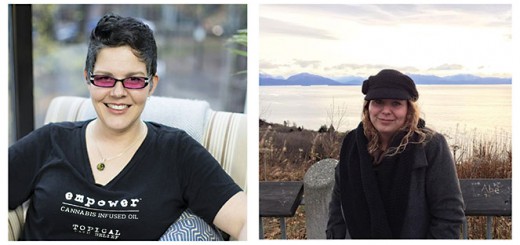As the week began, it looked as though the effort to implement Measure 91 was moving forward quickly. The work session on Monday began by introducing three amendments to HB 3400, and a second bill that focused on the point-of-sale taxation, HB 2041-2, which was not formally added to the agenda due to the lack of sufficient notice, but was provided for informational purposes only.
Representative Lininger announced that if the meetings extended into the next week, that the meetings would take place earlier in the day.
Legislative Counsel Mark Mayer introduced the proposed amendments for HB 3400, which included the dash 9, dash 10 and dash 11 amendments.
First, he covered the major changes to the dash 9 amendment from the draft copy covered in the previous meeting:
- Page 84, sections 117-118 previously addressed water and electric usage. In this version, they were replaced with cannabis education, under ORS 336.222 to emphasize marijuana education for the time being and report to the legislature on recommendations and whether money should be funneled into education.
- Page 97, which used to address early sales through medical marijuana dispensaries, was instead replaced with two task forces; the first is to study water, energy and other agricultural issues and the second is a local option task force, to study the local option issue to determine if legislative changes are needed in the future.
- Page 161 directs OLCC to make biannual report to the legislature about production amounts for licensed producers and amounts sold by retailers, and whether the supply is commiserate with demand, to ensure that the legislature is apprised of the situation.
- Page 41, which ties into the dash 10 amendment, section 34A is the local option tax, which only allows expressly authorized taxation and any local tax ordinance must be referred to the voters for approval at the next general election and the tax is capped at 3%.
Mayer also noted that the amendment was officially posted now, and no longer in draft form.
Senator Prozanski questioned whether the local tax had to be approved by voters before it was enacted, and Mayer said yes. Senator Burdick questioned whether requiring the tax issue to go to voters might slow down localities implementing retail outlets. She suggested that while voting at the general election might reduce costs, we might want to consider allowing flexibility on when the election takes place to speed up establishing retail outlets. Representative Lininger explained that the rationale behind requiring the vote to take place at the general election is that it was consistent with what voters passed for opting-out. She said that the idea was to enlist the members of the community in deciding if tax was an appropriate step and to do it at the same time as they were considering other marijuana issues.
Mayer then summarized the dash 10 amendment. He explained that it was the same language as SB 964, which had previously been passed on the Senate Floor, with two exceptions:
- The strong preemption language from section 32 of SB 964 was removed.
- The local opt-out language from sections 67-72 was also removed.
He also said that the definition of mature marijuana plant was corrected to align with what was found in Measure 91 and that there were a few other small changes, including allowing a dispensary that was kicked out due to the 1000 foot rule to reregister quickly.
Mayer then explained that the dash 11 amendment was simply an amendment to the dash 9 amendment to correct a drafting error that included a bad reference. He said that any other errors could be corrected in future sessions, and that hopefully there weren’t too many that needed corrected currently.
Mayer then explained the second bill, HB 2041-2. The bill is the tax provisions from the original draft of the dash 9, removed into a separate bill, because it was desired that an emergency clause be put on the dash 9. However, since all tax bills require that they go into effect at least 91 days after passage, the tax provisions had to be pulled out to allow the dash 9 to go into effect sooner.
The bill essentially moves the tax from a tonnage tax to a point-of-sale tax. It sets the tax at 17% for all products, although the drafting itemized various types of products to make it easier to change in the future if desired. If a county or city chooses to implement the 3% tax, to the total tax applied would be 20%. The Department of Revenue will use their normal means of collecting the tax, but the bill allows the Department of Revenue and the Oregon Liquor Control Commission to enter into an agreement for any purpose to enforce the provisions.
Burdick explained that if the revenue impacts of the bill were the same or less than Measure 91, then it wouldn’t require a 3/5 vote to pass, but if there is any question about revenues exceeding Measure 91, then it would require a 3/5 vote to pass. Representative Lininger explained that the intent was to keep the revenue from taxes at the same rate as passed in Measure 91, but because of differences in how the tax was levied and its inexact nature, they may call for a 3/5 vote just to be sure that “we aren’t on the wrong side of procedures”.
Burdick then questioned whether medical marijuana patients would pay taxes when purchasing recreational products from a retail establishment. She suggested that while it was clear in the language that they wouldn’t pay tax for medical products at dispensaries, or medical products at retail outlets, it was unclear if they would pay tax on recreational products sold at retail outlets. Conversation between committee members ensued that illustrates that products sold from OLCC licensed stores under the opt-in will be selling “medical products” and “retail products” and that both will be handled differently for tax purposes.
Senator Prozanski questioned whether we would be limiting the potency of products sold on the recreational market, ie if a product of 95% THC would be available through retail outlets for anyone to purchase or would be exclusively through dispensaries. Lininger wondered if the OLCC power to regulate potency covers that concern, and Mayer explained that the labeling and packaging provisions provide powers to the OLCC and Oregon Health Authority to distinguish between medical and recreational products.
Senator Ferrioli suggested that they should pursue the tax vote with an abundance of caution and insist on the 3/5 vote to prevent future litigation. Mayer said that the Legislative Counsel Office would recommend that it was always safer to put the revenue questions into a House Bill and get the supermajority vote to “put those concerns to bed”.
Senator Beyer asked how do medical and recreational products, and if the medical marijuana card determined the tax treatment of the purchase. Burdick said that the card did determine that, however the question was whether a patient’s tax-free status should extend to purchases of recreational products, distinguished by potency. Ferrioli suggested that if people want a more potent experience, they will simply purchase more product, and that the dosage should be for safety and purity. Mayer explained that none of the language proposed addressed specific products. While nothing prevents a medical product from being sold in an OLCC store, there is no language to consider a special exemption on taxes for medical marijuana patients in those stores - anyone who purchases a product from an OLCC store will currently pay the tax.
Senator Prozanksi suggested that rulemaking should include a “bright line” on potency that distinguished between medical and recreational products. Senator Beyer suggested that “we are involved in a fiction about products” and said that the difference should be whether or not the product is taxed. He stated that those with a medical card should be tax-free, and those without it should pay the tax. Lininger explained that if a patient purchases from a dispensary, there will be not tax. Beyer asked if a recreational user could purchase from a dispensary, and Lininger said no, to which Beyer said again, “That is a whole lot of fiction”.
Representative Buckley’s Staff then presented on energy usage and environmental impacts on the transitions from the cannabis industry. Buckley explained that he didn’t intend to impact indoor cultivation, but wanted to make sure that people understood the consequences of energy use and water, to determine the best practices. Andrea Phelps and Mary Beth Williams then presented on the issues.
Phelps reflected back to a February 23 presentation before the committee from PGE on anticipated energy requirements that concluded that Oregon has two choices: build new power plants or look at energy conservation. The PGE slide said that four marijuana plants grown indoor consume as much energy as 29 refrigerators. Buckley’s office was contacted my constituents that were concerned that increased energy use might bump them all up to a different tier for rates. Further researching the issue, Buckley’s Staff discovered other environmental issues surfacing in Washington and Colorado, including greenhouse gas emissions, water use and pesticide use.
Phelps then shared a long list of numbers, which she described as “staggering numbers”. She said that a a typical grow operation uses 1000 watt grow lights for 12-20 hours per day depending on the grow cycle. 10,000 square foot grow uses a minimum of 400 growlights, which use approximately 16 kW per day. The lights account for about 30% of the total energy usage, the rest is consumed with HVAC, water pumps and other uses - for both indoor and outdoor cultivation.
A few other numbers provided:
- 100 square foot grow would power 6 houses
- 1000 square foot grow would power 60 houses
- 5000 square foot grow would power 300 houses
- 10000 square foot grow would power 600 houses
She said that these numbers were small compared to existing facilities in both Washington and Colorado. She said of the current medical marijuana patients, if 100 shifted to 100 square foot operations, Oregon would add 657 mega Watts to usage, which is the equivalent of 60,000 new homes or the size of a new power plant. She also said that 1 pound of cannabis grown indoors produces 16 pounds of CO2.
Other states are dealing with these issues through piecemeal regulations. Arcata, CA levied a tax rate of 45% on homes that use six times more than the baseline usage; within one year 90% of homes exceeding that usage moved out into the county. Now the county is considering similar taxation. Boulder County also passed a tax. Other localities have required the use of renewable energy. Boulder currently requires that 50% of all energy used be renewable, and by 2016, 100% of energy must be renewable. She also mentioned the implementation of rebate programs, but suggested that they were hard to implement once people were up and running and that those in BPA or consumer-owned energy grids couldn’t take advantage of the rebates.
She said that growing requires 6-15 gallons of water per plant, and that pesticide use was not currently legal federally, but that Washington had set some specific set of pesticides allowed and Colorado had no regulations on the use of pesticides. She concluded that we either needed to conserve energy or build new power plants.
Senator Beyer suggested that consumer-owned utilities could set different rates for these types of companies and that he didn’t understand why these load statistics, which were comparable to server farms that local communities “salivate over”, would be treated differently. Buckley’s Staff answered that energy usage was already calculated out to 2020 without considering these increased loads, but that after 2020, those factors could be considered. She also explained that this was like having a few hundred data farms coming online in a very short period, so the concern was how much energy was taken from the grid in a relatively short amount of time.
Buckley concluded the presentation by saying that he appreciated the inclusion of a task force in the bill, because the numbers were staggering and this was something that we needed to be careful with.
Steve Marks and Jessie Sweet from the OLCC testified next. Marks expressed a “few areas of concern” that they had with the current language in the dash 9 amendment. He said that the language in Section 30 on page 37 regarding “primary residence” conflicted with the definition on page 6, line 18 for licensed premises. He said the current language would prevent them from inspecting a residence that was used for operational purposes, and he questioned the standard of “reasonable suspicion” for inspecting a primary residence.
Lininger explained that it was intended to safeguard primary residences but to allow inspections where there was cause to believe wrong-doing was occurring. Prozanski said that on page 6, lines 18-20, he had the impression that they were going to put a period after residence and drop the rest. He also questioned if reasonable suspicion would be sufficient to go into a primary residence instead of going into court for a warrant. Jessie Sweet from OLCC suggested that the OLCC doesn’t require records to be kept on the premise for liquor operations, so when they are considering whether or not the business is operated in the residence, they are referring to production, processing and sale, rather than bookkeeping or things of that nature.
Marks also questioned how and when the medical product comes into the system. He pointed to Sec 116, page 83, line 19, where the language refers to medical product coming into the system; he suggested that incorporating the word “may” into that language would allow discretion through rule-making. He explained that they understood that the excess medical product would be sold into the recreational side of the system. He said if the intention was it to remain “medical product” throughout, then the current language was fine.
Sweet explained that it was intended that a grower, with the patient’s permission, could sell excess through either medical dispensaries under HB 3460 or through retail outlets under M91. Marks explained that the ad hoc group had envisioned that medical cardholders would be tax-free in the recreational system for medical products, with an elaborate determination that, if a medical product wasn’t available, they could buy a tax-free recreational product with their card. Prozanski clarified that the language wasn’t intended to allow medical growers to extend their limits to recreational limits, but instead to just sell excess under the medical program. Lininger said that she felt it would be helpful if OLCC gave written comments on whether or not OLCC licensed medical growers would be able to grow for recreational and medical or medical limits only.
Prozanski questioned his earlier request for an “opt-out” provision for growers who opted in to OLCC licensing and then decided to opt-out. Marks said that they believed that the licensee would simply not pursue the rec license and that would opt them out at a future date.
Ferrioli questioned whether the OLCC intended to prohibit minors on the premises where growing, processing and sales occur. Marks explained that yes, they intended to craft a rule on the issue of minors, but they haven’t yet figured out how to address concerns about family members on the property of a licensed facility. He also questioned what happens when minors that are friends of the family visit, stating that they wanted to provide sensible accommodations.
Ferrioli pointed out that under liquor laws there are children allowed in in restaurants, and minors employed, using time, place and manner restrictions to enforce the rules. Distilleries, however, do not have such provisions allowing minors. He expressed concern about the fact that all state employees are mandatory reporters, so there is a “culture clash brewing”. He suggested that they needed to have a legislative conversation with regulatory agencies that are concerned with welfare, to resolve concerns with family farms and the obligation to protect children.
Lininger suggested crafting some sort of legislative intent to direct rule making agencies to consider that some operations happen on family farms and that the goal is to protect children from intoxicants and allow rule-making to handle the specific policy. Ferrioli suggested that a person who uses part of their home for processing could simply build a shed which might fix both concerns regarding kids and home inspections; he said that making it a condition of licensing that processing doesn’t occur in homes, particularly where there are children.
Lininger wrapped up saying that they were hoping to move forward with the language, ensuring that it matched their intent. Buckley said he had concerns that the language would allow someone to expand their grow size significantly by utilizing medical and recreational licensing and that he didn’t believe that was the intent. Burdick echoed those concerns, stating she never believed that they were discussing dual licensing, but a single license. Lininger suggested that the language could be modified to reflect in the statute that the medical plant limits apply if you are a medical grower.
Senator Kruse said that instead of opting in to the seed to sale tracking, he felt that it should be an opt in to sell to the recreational market. Burdick said that the opt in would require all the product to be tracked seed-to-sale from the get-go, and Prozanski restated his understanding of Kruse’s question, suggesting that there should be a means to allow the excess from the OHA system to also come into the recreational side. Lininger said that while it might not be ideal, what she believed they had decided on was to allow medical growers participating in the “reporting light” to sell to dispensaries only, but if you want access to the recreational market, then you have to select the seed-to-sale from the start. She suggested that while this might not be a “great deal”, it is what was decided and that for now, they should stick with that and fix it in future legislative sessions if desired. Burdick agreed.
Representative Olson said that “we need to be very careful that we aren’t reintroducing the black market” and suggested that Buckley “hit it on the head”.
Prozanski said he wanted to “call out” page 20 line 5 on the dash 9 amendment, and said that he wanted to make sure that grow operations were potentially going to be faced with reduced production limits when they renew their license. Burdick responded that they intended to put sideboards on the issue, considering energy usage and market demand, and allow the issue to be handled in rule because if it is in statute, that “it is stuck in statute”. Buckley questioned how we will be able to pull back if we end up with huge gardens. Lininger said it was her understanding that the statute was intended to allow people to graduate up, not up and then back, but just up.
Ferrioli suggested that the industry was preparing for national demand, while the committee was focused on local Oregon-only demand. He said that we were currently growing far more than Oregon needs according to the estimates given, and we were doing it without dramatic effects on water or electrical usage. He said that he was concerned that the bill would need rewritten every year. Lininger responded that the bill would probably need rewritten each year, as the issue evolves, and that success shouldn’t be measured on anticipating ever possible consideration for the next 50 years. She said that we have to “start somewhere” and keep addressing the changes in future years.
Burdick said that since it was illegal to sell marijuana across the borders, we needed to be able to tell the feds that “this is Oregon only, otherwise we are at risk.” Senator Kruse said that while the feds were likely to do something eventually, “how many decades have we been saying that?” He said while he didn’t want to see massive 100-acre pot farms, he also didn’t want a whole lot of restrictions. He suggested that it would be nice if we had so much marijuana that it drove the price down to adequately compete with the black market. Beyer said that the seed-to-sale tracking should be sufficient, and that we should let the market decide from there.






